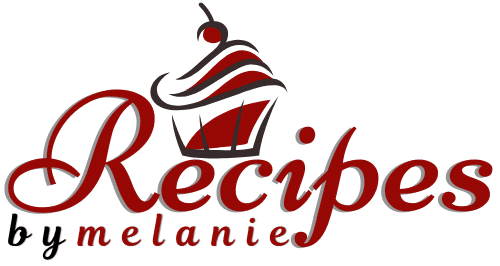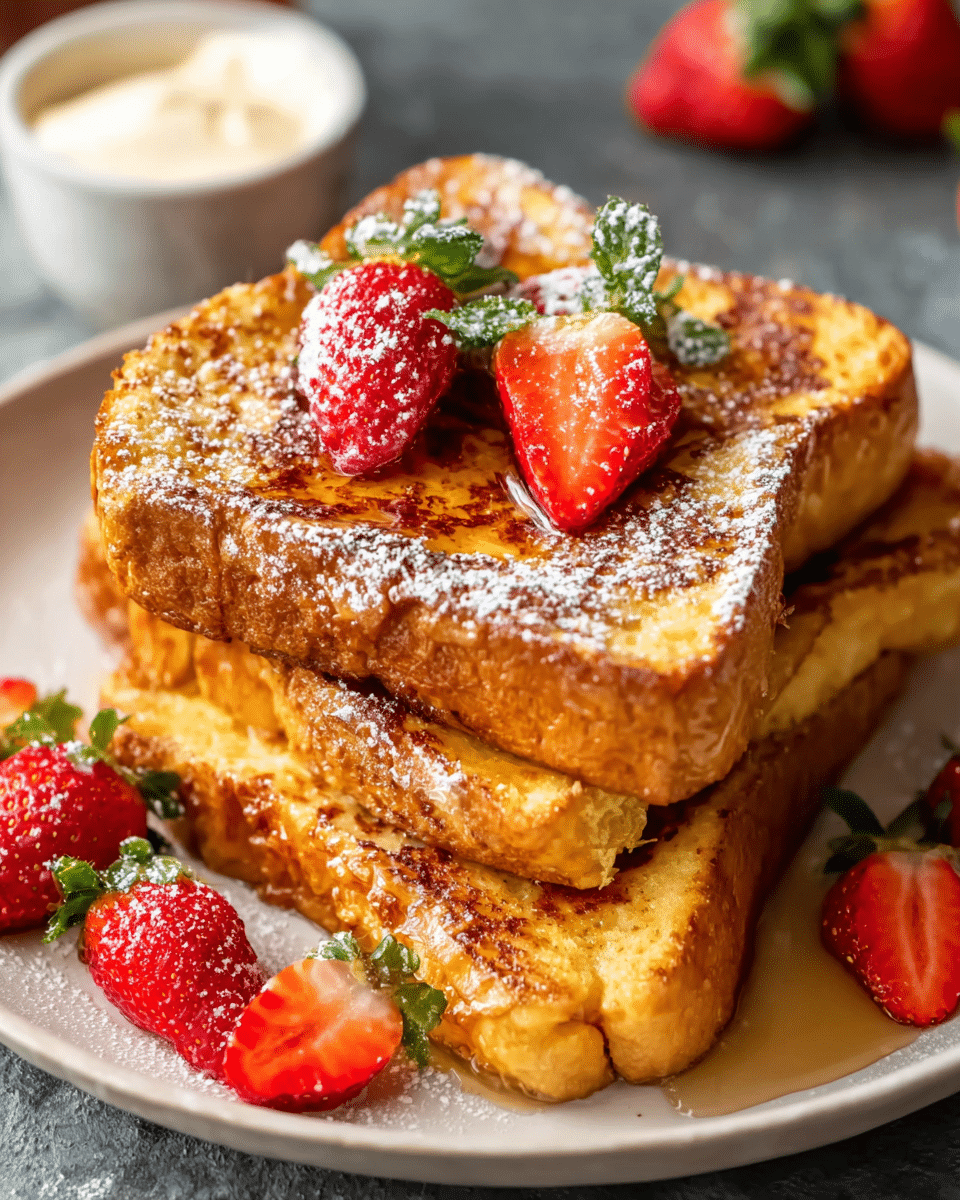This French Toast recipe is a classic breakfast that is both simple and indulgent. Perfectly golden and crispy on the outside with a custard-like, fluffy interior, this dish is elevated by a hint of cinnamon and vanilla. Served with your favorite toppings like maple syrup, powdered sugar, or fresh fruit, French Toast is a breakfast favorite that can be enjoyed by the whole family in just 20 minutes.
Full Recipe:
Ingredients
-
8 slices brioche bread (or Texas toast)
-
1/2 cup milk
-
4 eggs
-
1 tablespoon vanilla extract
-
1 tablespoon sugar
-
1 teaspoon cinnamon
-
Butter or cooking oil (for frying)
Directions
-
Make the Egg Mixture: In a mixing bowl, whisk together the eggs, milk, sugar, vanilla extract, and cinnamon until fully combined.
-
Prepare the Skillet: Heat a non-stick skillet or frying pan over medium-high heat. Add a small amount of butter or cooking oil to coat the pan.
-
Dip the Bread: Dip each slice of bread into the egg mixture, making sure both sides are evenly coated. Allow any excess mixture to drip back into the bowl.
-
Cook the French Toast: Place the coated bread slices onto the hot skillet. Cook for 2-3 minutes on each side or until golden brown and slightly crispy.
-
Serve: Remove from the skillet and serve immediately with maple syrup, powdered sugar, fresh fruit, or a dollop of whipped cream.
Nutrients (per 2 slices)
-
Calories: 404 kcal
-
Carbohydrates: 38g
-
Protein: 15g
-
Fat: 21g
-
Saturated Fat: 11g
-
-
Cholesterol: 287mg
-
Sodium: 394mg
-
Potassium: 113mg
-
Fiber: 0.3g
-
Sugar: 5g
The Bread: Choosing the Best Option
When it comes to French Toast, the bread you choose plays a crucial role in the final result. Brioche bread is a popular choice due to its rich, buttery flavor and soft texture, which soaks up the egg mixture beautifully, resulting in a custard-like interior once cooked. Its slightly sweet flavor complements the cinnamon and vanilla, adding a delightful depth to the dish. If brioche isn’t available, Texas toast is another excellent option. This bread is thicker and heartier, which helps it maintain its structure during the soaking and frying process.
The key is to use a slightly stale bread, as it absorbs the egg mixture more effectively without becoming too soggy. Fresh bread can work, but it might not soak up the mixture as well as day-old bread. If you don’t have brioche or Texas toast, any thick, hearty bread can work, so feel free to experiment with your favorites.
The Egg Mixture: A Perfect Custard Base
The egg mixture is the heart of French Toast. It’s where the magic happens, as the eggs create a custard-like texture that gives the bread its signature softness. In this recipe, the eggs are combined with milk, vanilla extract, sugar, and cinnamon, creating a flavorful base that coats the bread before it’s fried. The cinnamon adds warmth and a comforting spice, while the vanilla extract infuses the dish with a subtle sweetness.
To make the egg mixture, simply whisk the ingredients together until they are fully combined. This creates a smooth custard that will cling to the bread, infusing each slice with flavor as it cooks. The sugar in the mixture adds a touch of sweetness, while the milk ensures that the French Toast remains light and fluffy on the inside.
Cooking the French Toast: The Perfect Crisp
To achieve perfectly cooked French Toast, it’s important to have the right balance of heat. A non-stick skillet or frying pan is ideal, as it ensures even cooking and prevents the French Toast from sticking. The skillet should be preheated over medium-high heat to allow the bread to cook quickly and evenly.
Before adding the bread, lightly coat the skillet with butter or cooking oil. The butter adds richness and flavor, helping the French Toast develop a golden-brown, crispy exterior. Once the skillet is hot, dip each slice of bread into the egg mixture, making sure both sides are fully coated. Allow any excess mixture to drip off before placing the bread onto the skillet.
Cook the bread for about 2-3 minutes on each side, or until golden brown and slightly crispy. The bread should be firm to the touch, with a slight crunch on the outside, and soft and fluffy on the inside. Be sure not to overcrowd the pan, as this can lower the heat and result in uneven cooking. If needed, cook the French Toast in batches.
Serving French Toast: The Best Toppings
French Toast is incredibly versatile when it comes to toppings. The most traditional and beloved option is maple syrup, which drizzles beautifully over the crispy, golden bread. The sweet syrup enhances the flavors of the French Toast without overpowering it, creating a balanced and satisfying breakfast experience. For an extra indulgent touch, a dusting of powdered sugar adds a light sweetness and a touch of elegance to the dish.
Fresh fruit is another excellent topping choice. Sliced strawberries, bananas, or blueberries add a burst of freshness and natural sweetness that pairs wonderfully with the rich, warm French Toast. If you’re in the mood for something even more decadent, a dollop of whipped cream adds a creamy, light topping that complements the crispy bread.
For a savory twist, try topping your French Toast with crispy bacon or a drizzle of warm honey. This creates a balance of sweet and savory flavors that is sure to please a variety of taste preferences.
Making French Toast for a Crowd
If you’re serving French Toast for a crowd or preparing it for a special brunch, this recipe can easily be scaled up. Simply double or triple the ingredients, depending on how many people you need to serve. If you don’t have enough space on your skillet, you can cook the French Toast in batches and keep it warm in the oven. Preheat the oven to 200°F (93°C) and place the cooked French Toast on a baking sheet. Cover loosely with aluminum foil to keep it warm while you finish cooking the remaining slices.
Nutritional Considerations
While French Toast is undoubtedly a delicious treat, it’s also a dish that is rich in calories and fat, primarily due to the eggs, milk, and butter used in the recipe. Each serving (2 slices) contains around 404 calories, with 21 grams of fat and 15 grams of protein. It’s a hearty breakfast that can keep you satisfied for hours. However, if you’re looking to reduce the calorie count, you can make a few adjustments. For example, using lower-fat milk or egg substitutes can help cut down on the fat content. You can also use less butter or opt for a healthier oil when frying the bread.
For those watching their sugar intake, consider using a sugar substitute or reducing the amount of sugar in the egg mixture. Keep in mind that the toppings you choose can also affect the nutritional profile, so opting for fresh fruit or a small drizzle of syrup instead of heavy toppings can make the meal a bit lighter.
Conclusion
French Toast is a timeless breakfast favorite that brings joy to any morning. With its golden, crispy exterior and soft, custard-like interior, it’s the perfect balance of texture and flavor. The rich egg mixture, infused with vanilla and cinnamon, creates a satisfying custard that soaks into the bread, resulting in a deliciously indulgent dish. Whether you top it with maple syrup, fresh fruit, or whipped cream, French Toast is a versatile and customizable breakfast that can be enjoyed in so many ways.
Perfect for weekend mornings, special occasions, or a quick weekday breakfast, French Toast never goes out of style. It’s easy to prepare, delicious, and sure to please everyone at the table. So the next time you’re in the mood for a classic breakfast, reach for this simple and satisfying recipe that will make your mornings a little sweeter.






